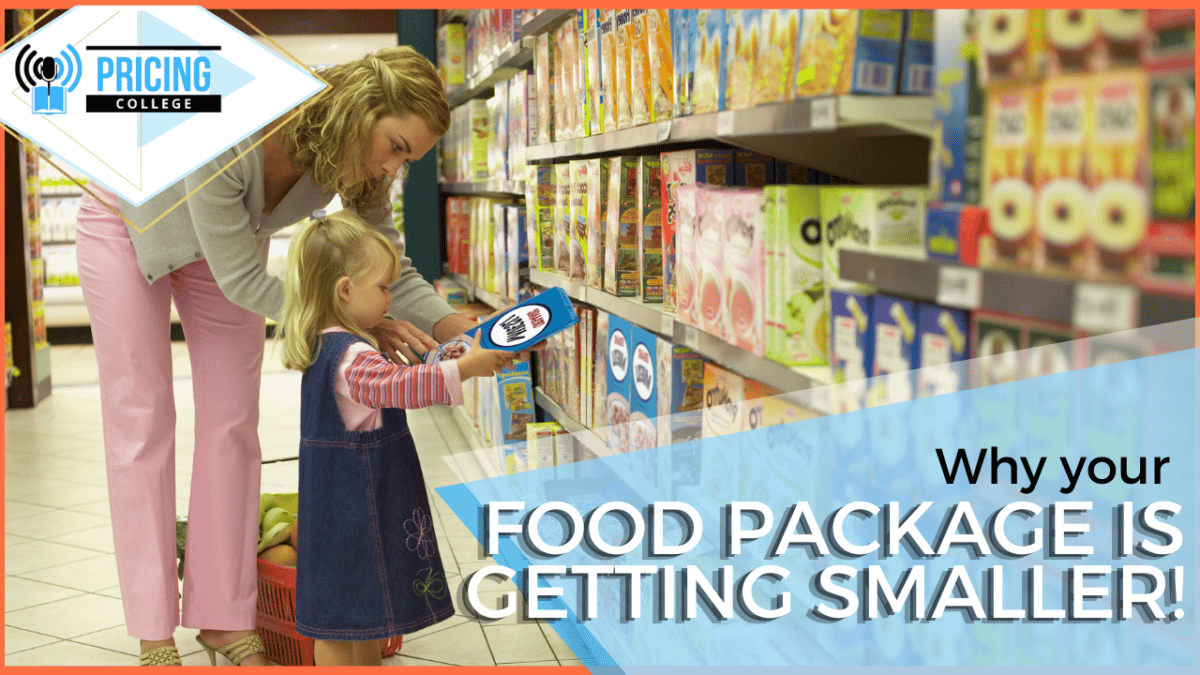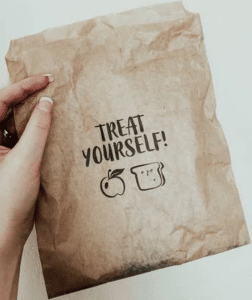
Why your Food Package is Getting Smaller! 🤔Podcast Ep. 34
In today’s episode, we look at the practise by food product companies to reduce pack size (why food package is getting smaller) – sometimes without the customer noticing – rather than increase the price.
Have you noticed that some items – like cereals etc. or the number of bags of chips in a multipack is getting smaller or fewer?
What would you say if your pint of milk (or beer!) gets slightly smaller every year – but the price tag stays the same?
This is called shrinkflation.
Listen on Apple Podcasts Listen on Spotify Listen on Google Podcasts Listen on Stitcher Listen on Amazon Music
TIME-STAMPED SHOW NOTES
[00:00] Introduction
[01:30] Shrinkflation
[03:00] Why do manufacturers reduce pack size?
[05:05] Do consumers notice that pack sizes are getting smaller?
[06:00] Cost-plus mentality
[06:57] Customer value driver for health as a reason for shrinking the box sizes
Is today’s food package getting smaller?
Have you ever thought about pack sizes getting smaller? Have you thought when you’re eating your favourite cereal or drinking your favourite cans of Coke.
Got these packs are getting smaller than they used to be? Maybe it’s just me or is it happening, our packs getting smaller?
So obviously, inflation generally affects the entire economy in the basket of goods that we purchased. We are used as people to sing what $1 bought last year or $1 bought 10 years ago, it doesn’t buy the same nowadays.
In the post-COVID World, deflation is starting to impact a lot of countries, which has impacted Japan in recent years. But still, fundamentally we do expect prices to increase year on year or every couple of years.
So, you might have bought a large box of cereal for the family might have cost $2. And then somewhere down the line you expect to slowly increase.
Sometimes those companies rather than increasing the prices actually just make that box slightly smaller.
This is a concept called shrinkflation.
It’s a term that people use just to describe products pack sizes getting smaller.
What are the examples of food packages getting smaller?
I suppose a good example of that would be cereal. Cereal boxes have got smaller and often when they’ve got smaller they’ve changed the bundle or the mix of products.
For instance, kids products now offer a range of smaller pack sizes for one almost like portion control. But seven of them in a packet.
But all of them are much smaller than they used to be so there’s a mixed thing happening here as well as shrinking product size.
Reasons why our food package is getting smaller
I think different value drivers have smaller packages and I think we’re going to cover that in a future episode.
But really in this episode, we want to drill into is the right choice for a manufacturer of consumer goods. Food and drink are what we’re talking about.
Is it the right thing to think that customers would prefer static prices?
A dollar today is a dollar tomorrow?
Or would they just more happily pay the 10% increase?
A lot of companies fear putting through price increases, the fear that there will be a drop off in demand. And the price elasticity will mean that demand will fall.
Is that true?
Or are they tricking the customers? Or are they tricking themselves?
Well, I think the assumption here is that customers are very price sensitive. And if they were to learn on a price increase that they wouldn’t buy the product.
Therefore, manufacturers are making pack sizes smaller to prevent that from happening. Is that true? Has it been tested?
No, because what manufacturers tend to do is avoid that sort of awkward conversation with consumers. And, in turn, they reduce the pack size.
What does that reducing the pack size mean?
They’re trying to increase margins on the cost side by reducing their costs as opposed to thinking about pricing and demand for their product.
And having a frank conversation with consumers saying.“If you want this product, this is the price. And we’ll have to increase the price if you want more or less.”
These are the reasons why that sort of conversation hasn’t happened so people are now focusing on maximising margins by reducing costs.

Do customers notice that food packages are getting smaller?
I personally think the companies are kidding themselves a bit with this. The example I always give is if people are used to buying things in certain amounts or sizes, like a pint of milk, or a pint of beer.
If I give you the example of a man who went to a bar or a lady, of course who went to a bar and bought a pint of beer. And if year by year that pint of beer was getting smaller and smaller but the cost is staying the same. At a certain point in time, they would think it’s getting ridiculous.
I think that applies to most situations. I also think that when pack sizes decrease in size, customers aren’t going to. Or if you decrease the packet of a box of cornflakes by 10%, you’re not going to an average buy an extra box every 10 boxes. You are, in theory, you’re just going to buy less of it.
Sales volume as food package is getting smaller
What the companies are doing to some extent is, they are just decreasing the volume. And putting a cap on the sales and the monetary value of the sales also.
I suppose another assumption here is that a lot of consumers maybe don’t know that the pack sizes are getting smaller. It’s not a massive concern of theirs.
They sort of overlook it from day to day. And through that sort of psychological humans sort of just getting used to things day-on-day.
You don’t notice manufacturers could cut costs by reducing the pack size because nobody’s making a complaint about it. However, I suppose like everything, there are different segments in the market and some customers do notice.
Paying more as food package gets smaller
The question is,” would they be willing to pay more even for a smaller pack size versus a bigger pack size? ”
And the answer is manufacturers don’t know. They haven’t asked that question because they keep sidetracking.
This shrinkflation was the word Joanna used. My personal view is that this stems from a real dedication to the cost-plus mentality.
Fundamentally, you’re not thinking about what the customer wants. You’re purely thinking about cost and margin and accounting and those sort of aspects.
Why is the customer buying that pack size? Why is the customer buying that pint of beer or that box of cornflakes?
Costs for shrinkflation as food package is getting even smaller
The cost comes in but it’s the value that they get from it. So, are you shrinking the box size based on the value to the customer? Or are you simply shrinking it from a cost-plus accounting approach?
I can understand family sizes and household units. It might make more sense to have seven disposable units in your box of cornflakes that you open morning today if you’re one person.
But shrinking it by 10%, tricking the customer. Fundamentally, think that’s you’re only tricking yourself.
Is health the reason for food packages getting smaller?
I think there’s one company that recently came out Mandalas about the reasons for shrinkflation. And they associated the smaller pack size with the new trends for health.
We’re making this smaller because people need to learn how to manage their diet. They need to know what calorie counts are in each of these boxes.
We need to get that chocolate bar under 100 calories for instance, like portion control. But other than that, I haven’t heard of another manufacturer using that sort of customer value driver for health as a reason for shrinking the box sizes.
That’s a sort of a new announcement really in FMCG. It’s probably something we’re going to hear a lot more, it’s for our benefit.
It could be like a tokenistic phrase but, is that the reason? It’s still about reducing costs to maximise margins as opposed to demand.
I think in that instance that the example given of the calorie counting etc. I almost think that’s a value add. And I think a lot of people will pay more for that.
It’s almost like having a personal trainer. Looking over your shoulder and saying no-no to that extra piece of rice or that extra chips.
So to some extent, I would say you should have increased prices in that scenario. But I think that’s a topic we intend to cover in a future episode.
Bottomline: Not only food package is getting smaller but also household products
I suppose this last example I’d like to give is that there are some packs that have been reduced in size. And I’m thinking even household goods like washing powder. They’re getting smaller in size too.
Over years they get smaller and then after a while you get a value pack with 20% more introduced. But actually, that value pack is the same size as the original size when that product was first launched.
But the price hasn’t changed. You’re not getting 20% more. You’re probably the price is sort of you’re paying more than you would have done before.
So, even though they’re shrinking products when they reintroduce value packs it was sort of that the normal size pack that you would have had three years ago.
Yeah, so, let’s all go to Costco and stock up. I’ve been doing that over the last few months in my bunker, but I don’t recommend it to everyone because we don’t want panic buying. So that’s it for me today.
For a comprehensive view on building a great pricing team to prevent loss in revenue,
Download a complimentary whitepaper on How to Build Hiring Capability To Get The Best Pricing Team
Related Posts
Leave a Reply Cancel reply
Categories
- marketing strategy (26)
- Organisational Design (14)
- Podcast (114)
- Pricing Capability (87)
- Pricing Career Advice (10)
- Pricing Recruitment (19)
- Pricing Strategy (290)
- Pricing Team Skills (13)
- Pricing Teams & Culture (24)
- Pricing Transformation (47)
- Revenue Model (25)
- Sales Effectiveness (27)
- Talent Management (7)
- Technical Pricing Skills (35)





